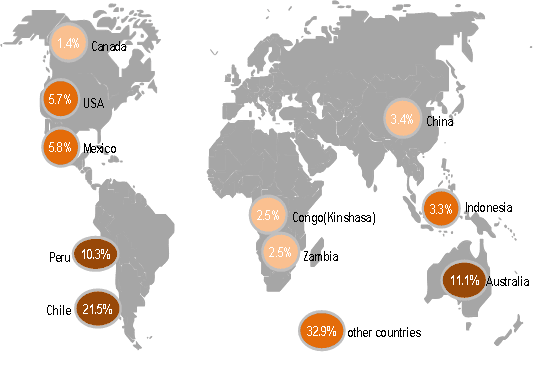Mineral resources are the backbone of the global economy, fueling industries from construction to technology and beyond. The distribution of these precious resources is uneven across the globe, leading to significant disparities in wealth and economic development. In this blog post, we will explore the ten countries that are endowed with the most abundant mineral resources, highlighting their key minerals and the implications for their economies and global markets.

1. Russia
Russia stands at the forefront in terms of mineral wealth, boasting vast reserves of coal, natural gas, and a variety of metals, including nickel, aluminum, and palladium. Notably, Russia is the world’s leading producer of nickel and palladium, critical components in electric vehicle batteries and various electronic devices. The country’s expansive geography, ranging from the Ural Mountains to Siberian regions, facilitates the extraction of resources. Continued investments in mining technologies and infrastructure are vital for Russia to capitalize on its mineral wealth sustainably.
2. United States
The United States is rich in a wide array of mineral resources, including copper, gold, silver, and coal. States like Nevada are instrumental in gold production, while the Appalachian region is significant for coal mining. Furthermore, the U.S. is a leader in the extraction of rare earth elements, essential for high-tech applications and renewable energy technologies. Enhancing domestic mining operations and reducing reliance on imports have become key focal points in U.S. economic policies, particularly in light of growing global competition.
3. China
China is not only the world’s largest consumer of minerals but also one of the richest countries in terms of mineral resources. Among its diverse mineral wealth are significant deposits of coal, iron ore, aluminum, and rare earth elements. The nation dominates the production of rare earth materials, which are crucial for electronics, military applications, and green technologies. China’s strategic focus on bolstering its mining sector and securing supply chains globally has solidified its position as a mineral powerhouse.
4. Australia
Australia is renowned for its rich deposits of iron ore, bauxite, and gold. The country is the largest exporter of iron ore in the world, predominantly to China, helping to drive both economies. Australia’s mining sector is supported by advanced extraction technologies and a regulatory framework that promotes sustainable practices. Furthermore, its abundant reserves of lithium are becoming increasingly valuable as the world shifts towards sustainable energy solutions, such as battery technology for electric vehicles.
5. Brazil
Brazil is home to a wealth of mineral resources, particularly iron ore, bauxite, and gold. The Carajas Mine, located in the northern region of the country, is one of the largest iron ore mines globally, contributing significantly to the country’s exports. In addition to its wealth in metals, Brazil also possesses sizeable reserves of other valuable minerals, such as nickel and manganese. The mining sector in Brazil plays a crucial role in the national economy, generating jobs and stimulating investments.
6. South Africa
South Africa is a mineral-rich country known for its vast deposits of gold, platinum, diamonds, and chromium. The significance of South Africa’s mining industry cannot be understated, as it contributes a substantial portion to the nation’s GDP and exports. The country is the world’s largest producer of platinum and holds a commanding share of global gold production. Challenges such as labor disputes and regulatory hurdles remain issues for the sector; however, continued exploration and investment could enhance South Africa’s standing in the global minerals market.
7. Canada
Canada is one of the most resource-rich nations, with vast deposits of gold, copper, nickel, and potash. The country also boasts significant reserves of uranium, making it a key player in nuclear energy production. Canadian mining companies are known for their commitment to sustainable practices and technological innovation, enabling them to capitalize on the country’s mineral wealth while prioritizing environmental stewardship. Moreover, the Canadian government actively supports mining exploration and development, further enhancing the sector’s growth prospects.
8. India
India is rich in a variety of minerals, including coal, iron ore, bauxite, and chromite. The Indian mining sector plays a pivotal role in industrial development, providing essential raw materials for manufacturing and construction. With the country’s significant reserves of coal, India is among the world’s leading producers of this vital resource, though it also faces challenges related to regulatory processes and sustainability practices. Investments in modern mining technologies and infrastructure improvements are crucial to harness India’s mineral potential effectively.
9. Chile
Chile is synonymous with copper, being the world’s largest producer of this essential metal, which is critical for electrical wiring and various industrial applications. The country’s mining sector is a cornerstone of its economy, contributing significantly to both national revenue and employment. Additionally, Chile has vast reserves of lithium, an increasingly valuable resource due to the rise in demand for electric vehicle batteries. With a stable regulatory environment and abundant mineral resources, Chile is well-positioned to continue its dominance in the global mining landscape.
10. Indonesia
Indonesia possesses a wealth of natural resources, with significant reserves of gold, copper, and coal. The country is among the top global producers of tin and ranks favorably for its nickel reserves, which are crucial for battery production in electric vehicles. Indonesia’s mining sector has attracted substantial foreign investment, but it faces challenges related to regulatory compliance and environmental degradation. Striking a balance between economic growth and sustainable practices will be essential for Indonesia to maintain its mineral wealth.
Conclusion
The abundance of mineral resources in these ten countries shapes not only their economies but also the global mineral market. As demand for minerals escalates—driven by technological advancements and a transition toward sustainable energy solutions—understanding the dynamics of these resource-rich nations becomes paramount. Each of these countries presents unique opportunities and challenges, necessitating strategic planning and responsible management of their vast mineral wealth. In an increasingly interconnected world, the interplay between mineral resources and global trade will continue to evolve, influencing both economic prospects and geopolitical relations. dcpipe-piping system expert

